Hoyt Curtin is to animated television shows what Carl Stalling is to theatrical cartoons. Before he truly made his mark with Hanna-Barbera, the Downey, California native worked primarily in commercials. At least one such commercial was an animated spot for Schlitz Beer, animated by the fledgling studio. The following might possibly be an example, part of the “Move Up to Schlitz” campaign. It certainly has that early Ruff and Reddy sound.
Curtin also composed the score for a film with an ultra-low-budget budget called Mesa of Lost Women (1953). It stars Jackie Coogan as a mad scientist. Curtin’s score is primarily confined to Spanish guitar and percussion.
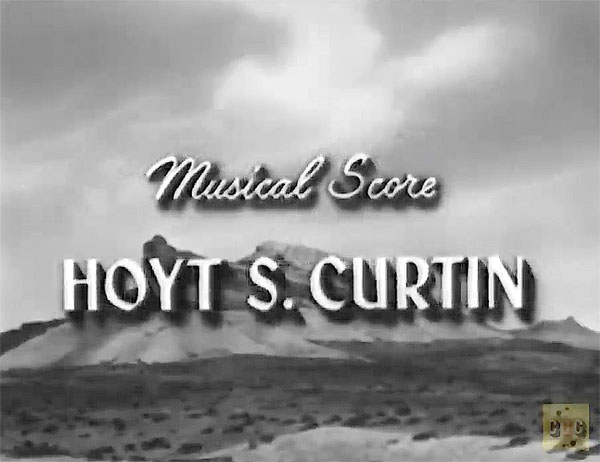
The following year, Curtin’s Mesa score cues were picked up for re-use by the notorious budget-challenged director, Ed Wood, for what some call “one of his most coherent films.” The title of the crime thriller, Jail Bait, does not refer to underage females in this case, but instead to a convicted criminal whose possession of a firearm violates his parole, hence the term. Curtin’s name was misspelled as “Kurtain” in the credits. Curtin reportedly contributed cues to Wood’s “masterwork,” Plan Nine from Outer Space.
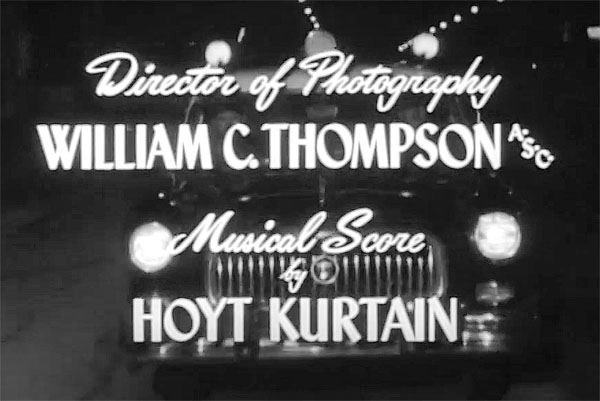
He chose to move on from Hanna-Barbera after Jonny Quest, occasionally providing a theme here and there. In his place was the talented Ted Nichols, the “Milt Franklin” of H-B. Like many people, Curtin was welcomed back to the studio in 1972. Around the time he composed and conducted the score for 1975’s Timber Tramps, a 1975 logging adventure that might have been an attempt at the “four-wall” movie release marketing technique that had proved so profitable for Billy Jack and the “Wilderness Family” films. This score reflects the seventies Curtin style.
He also composed and conducted the music for two Hanna-Barbera theatrical films: the high-concept comedy C.H.O.M.P.S., and animated feature Heidi’s Song (1982). Curtin’s concurrent Hanna-Barbera work includes music for Q.T. Hush (1960), Beany and Cecil (1962), Linus the Lionhearted (1964), and Battle of the Planets (1975).
Curtin’s work graced many recordings, but there was only one that he created on his own. Hollywood Directory is a collection of songs and instrumentals that pay tongue-in-cheek homage to the city. The album probably served as a sampler of what he could do outside of cartoons. If it was sold in stores, the distribution must have been highly limited.
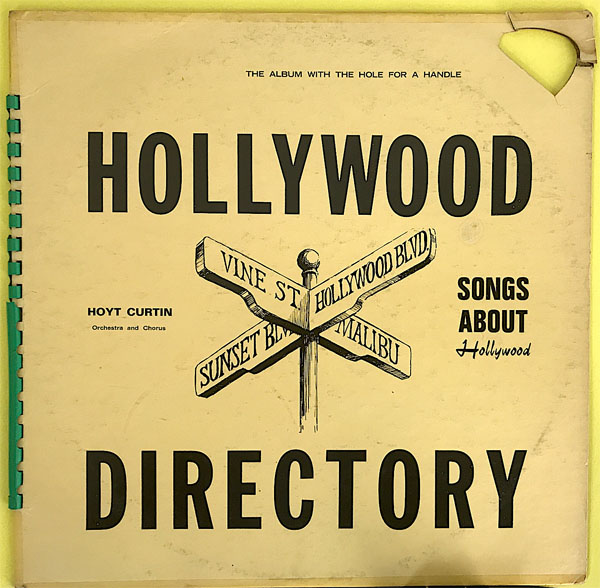
HOLLYWOOD DIRECTORY
Songs about Hollywood
Hoyt Curtin Orchestra
with Jackie Ward, Billy Strange, Bobby Adano, and The Randy Van Horne Singers
Soundtrack Records MFA-1024 (Mono)
Released in 1965. Producer: Hoyt Curtin. Arrangements: Jack Stern, Hoyt Curtin. Engineers: Dave Hassinger, Ivan Fisher. Musicians: Paul Smith, Buddy Cole, Hoyt Curtin (piano); Andy Kostelas (Saxophone, flute); Tommy Shepard (trombone); George Hyde (French horn). Recorded at RCA Studios, Hollywood.
Songs: “I Love Green (Street),” “Motorcycle Man (Cruisin’ Down Selma),” “Over the Garden Wall (On Gower Street),” by Hoyt Curtin. “Sunset Boulevard,” “Strollin’ Down Vine Street” by Hoyt Curtin, Bill Hanna, Joe Barbera. “Los Angeles (California)” by Curtin and Barnett.
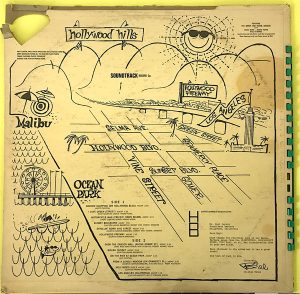
Instrumentals: “Window Shopping (On Hollywood Blvd),” “Hollywood Freeway,” “Malibu Sunset,” “From A Lonely Window (On Grammercy Place),” “Hollywood Hills” by Hoyt Curtin, Bill Hanna, Joe Barbera. “On the Pier at Ocean Park” by Liz Curtin.
Side one opens with Curtin’s favorite music: jazz. “Window Shopping (On Hollywood Blvd)” is one of those brisk, hustle-bustle pieces one might associate with a hectic downtown. Next up is Jackie Ward, who sang “Like I Like You” for Cindy Bear in Hey There, It’s Yogi Bear (1964), who lends a wistful vocal to Curtin’s “I Love Green (Street)”. Providing backup is The Randy Van Horne Singers, known to Hanna-Barbera fans as the group singing the themes to The Flintstones, The Jetsons, Top Cat, and other shows. The next track, “Motorcycle Man,” is performed by Bobby Adano, who sang and narrated the LP version of American-International’s Alakazam the Great (explored in this Animation Spin). Adano croons it in a Bobby Darin style.
Next is “Sunset Boulevard”, is not to be confused with Andrew Lloyd Webber show tune that came decades later. This particular “sophisticated sixties” instrumental is one of six tracks credited to Bill Hanna and Joe Barbera as well as Hoyt Curtin. It sounds as if it could have been a Top Cat cue. The Van Horne Singers provide some cool “doodley-doos.” Speaking of Top Cat, “Strollin’ Down Vine Street” is an extended version of the memorable “Nurse LaRue” music from the episode, “Top Cat Falls in Love.” The arrangement puts one in the mind of an elegant Henry Mancini / Audrey Hepburn film. Side one ends with “Hollywood Freeway” has a dual identity. This sound effects-laden, Raymond Scott-ish novelty number was also released as a single called “Quarry Stone Rock” by Fred Flintstone and His Orchestra. The single was issued on “B-H Records,” a precursor to Hanna-Barbera Records.
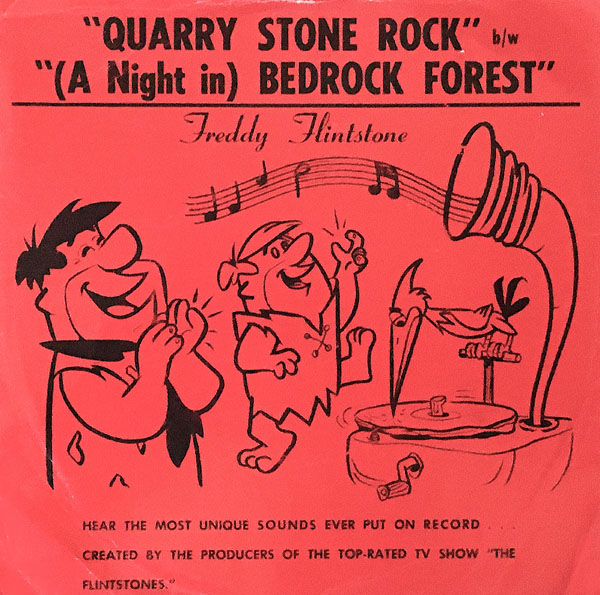
Bobby Adano returns on side two with “Over the Garden Wall,” a nineteenth-century English folk song. His inspiration here seems to be a young Jack Jones, who many years later, recorded a different version for the 2014 animated eponymous Cartoon Network series. The close of this arrangement is reminiscent of The Magilla Gorilla Show’s end titles. The next tune,“Malibu Sunset,” could have been the musical background for a tropical trip by T.C. and the gang. That is followed by another instrumental peppered with sound effects, “On the Pier at Ocean Park” is credited to Curtin’s wife, Liz. Almost a decade later, this became the theme to Hanna-Barbera’s charming ABC Saturday morning series, These Are the Days, featuring the voices of June Lockhart, Pamelyn Ferdin, and Henry Jones.
Next is a schmoozy romantic instrumental featuring Andy Kostelas on saxophone, “From A Lonely Window (On Grammercy Place)” sounds like a seductive scene to underscore Ginger Grant, Cinnamon Carter, or Miss Kitka. Then comes “A Night in Bedrock Forest,” which is the flip side of the Fred Flintstone Orchestra single. On this album, it is called, “Hollywood Hills.” The sound effects (especially the coyotes) suggest that “Hollywood Hills” predated the Flintstone disc.
The album closes with “Lost Angeles (California).” This is what I like to call “Jetson Jazz,” capturing the flavor of vintage Hanna-Barbera themes and production numbers. A spectacular arrangement reminiscent of Hoagy’s Carmichael’s “Yabba Dabba Doo” production number, or even “Meet the Flintstones” itself. Befitting its very sixties Chamber of Commerce vision of L.A., the tune has a swaggering Rat Pack-type vocal by guitarist/singer Billy Strange, whose vocal versatility is exemplified by this very different performance on the classic Sherman Brothers/Camarata LP, Tinpanorama, which was covered in this Animation Spin.
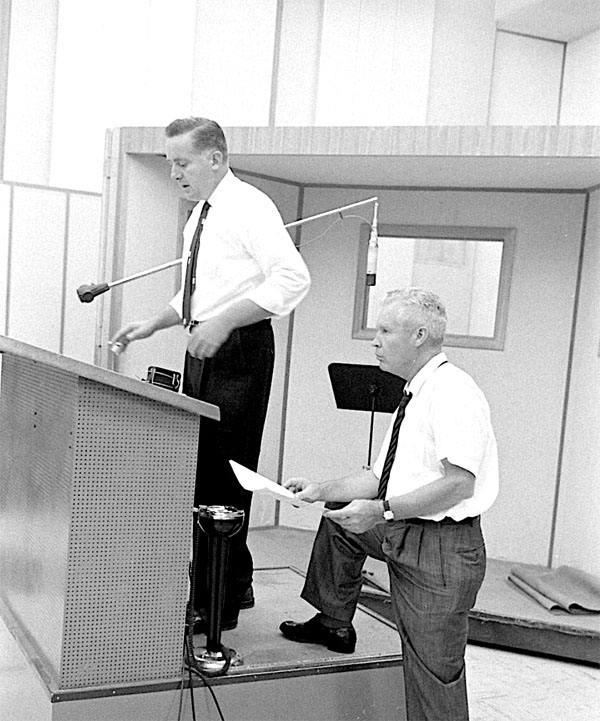
Happy Birthday Hoyt Curtin (left, with Bill Hanna on right).


 GREG EHRBAR is a freelance writer/producer for television, advertising, books, theme parks and stage. Greg has worked on content for such studios as Disney, Warner and Universal, with some of Hollywood’s biggest stars. His numerous books include Mouse Tracks: The Story of Walt Disney Records (with Tim Hollis). Visit
GREG EHRBAR is a freelance writer/producer for television, advertising, books, theme parks and stage. Greg has worked on content for such studios as Disney, Warner and Universal, with some of Hollywood’s biggest stars. His numerous books include Mouse Tracks: The Story of Walt Disney Records (with Tim Hollis). Visit 





















































By coincidence, my wife and I saw Andrew Lloyd Webber’s “Sunset Boulevard” just two days ago. It was great. But this….
Are you saying that it’s not known for certain “if [Hollywood Directory] was sold in stores”? Because I can see why retailers might not want to stock an album with such a bland, ugly, amateurish cover design. It looks like an actual directory, right down to the comb binding: something you’d open up if you wanted to find a dentist, not to listen to music. As long as Curtin was springing for all those top session musicians, he might as well have gone the extra mile and hired a graphic artist to come up with a more appealing and eye-catching cover. It’s not as though he didn’t have any contacts in the business. Oh, and that whole “hole for a handle” gimmick — really dumb.
The musical performances, on the other hand, are uniformly solid and professional. The trombone work recalls that of Stan Kenton’s band, as one would expect; most, if not all, of the trombonists Curtin worked with at H-B were Kenton alumni. “Motorcycle Man” is reminiscent of the theme to “Mr. Downtown” in “That Thing You Do”; in the mid-’60s, nothing screamed “COOL!” like cadencing on a minor/major ninth chord, again and again. I had to laugh when the song quoted Rachmaninoff’s Prelude in C# Minor — I’m sure Curtin didn’t “ask permission” for that!
Still, the album is a very mixed bag, not in quality but in its very sense of identity. Is it a jazz album, a kids’ album or a novelty album? Is it a commercial release or an industry promo? In any case, Curtin never made another one like it, and within a few years he was back to composing for TV animation, where he belonged. Who says there are no happy endings in Hollywood?
I was not aware at all that he had done music for “QT hush“. I’ve always considered the score to that cartoon very similar to the Avery MGM cartoon “who killed who?“! Otherwise, a very entertaining musical selection here this morning. Great article! I always wish that a lot of this music could be found on CD somewhere! Would make a great special feature on any Hannah Barbera collection of the future (hint, hint)!
Hoyt Curtin is an often unsung hero in the annals of American television and movies. He deserves recognition, much more than he usually receives. Many of us grew up on his melodies without necessarily knowing the name of the composer.
A few years ago, when the Sunday newspaper was still a highlight of the weekend, I embarked on a crossword puzzle, and found the first few items somewhat doable, so I continued. Then one of the clues I came upon was “Musician Hoyt” and eagerly I wrote in the letters: C-U-R-T-I and then realized there weren’t enough spaces for his full name. Now, I am stubborn when it comes to crossword puzzles, and when I know I’m right, I know I’m right. I make the letters fit one way or another. Thus, all of the Down items that intersected with this Across item had to fall in line with my authoritative knowledge. Resulting in a few nonsense words. The point of all this is that, it was another Hoyt altogether who was intended in this crossword puzzle–but it SHOULD have been Hoyt Curtin! This is what I mean when I say he deserves more recognition than he gets.
The NEXT time I find the name “Hoyt” in a crossword clue, it is simply going to HAVE to be “Curtin” as the answer!!!
My take on the “Los Angeles” song is a little different than yours, Greg. It puts me much more in mind of Top Cat than of the Jetsons–although I totally respect your idea of it. In any case, it was a great listen, and certainly puts me in the mind of those times–musically, that is.
Thanks for the mention in the book. I was absolutely amazed! I mean, I knew I was going to like the book, but now I have a special reason to treasure it!
Hoyt Axton is likely to be much better known to the average American of the late last century than Hoyt Curtin.
Mesa Of Lost Women is a watchable film, where you either like the strange music (I do) or you find it too obtrusive.
Adore “Strollin’ Down Vine Street” –
What Earl Kress could have done with the TC soundtrack on CD if he had been still alive.
It would have been marvelous if the new Top Cat blu ray came with music only tracks for every episode
(if only Warner Archives had a little bit more money)
As a relative Hoyt Curtin, old myself now, I love to read these articles about a great guy and fine musician.. I am imagining anyone other than a senior would not understand why the infamous “ugly and dumb” Hollywood Directory” album cover was so cheesy. Hoyt and his two brothers grew up in the Depression in So. Cal. and then served in the Navy as did his two brothers. Hoyt was a child prodigy, first a boy soprano, then a gifted pianist, composer and funny guy. His initial desire was to compose scores for movies, but life took its own course. Hoyt was able to work with the best musicians from the L.A. Philharmonic, Big Band musicians. Interesting interview from 1995 with Curtin. Yes, he grew up in the Big Band era, loving jazz, first as a musician then as a composer needing to make a living for his family.
Hoyt Curtin has a modern Toon Age melody (https://www.latimes.com/archives/la-xpm-1995-07-23-tv-26809-story.html).
Loved